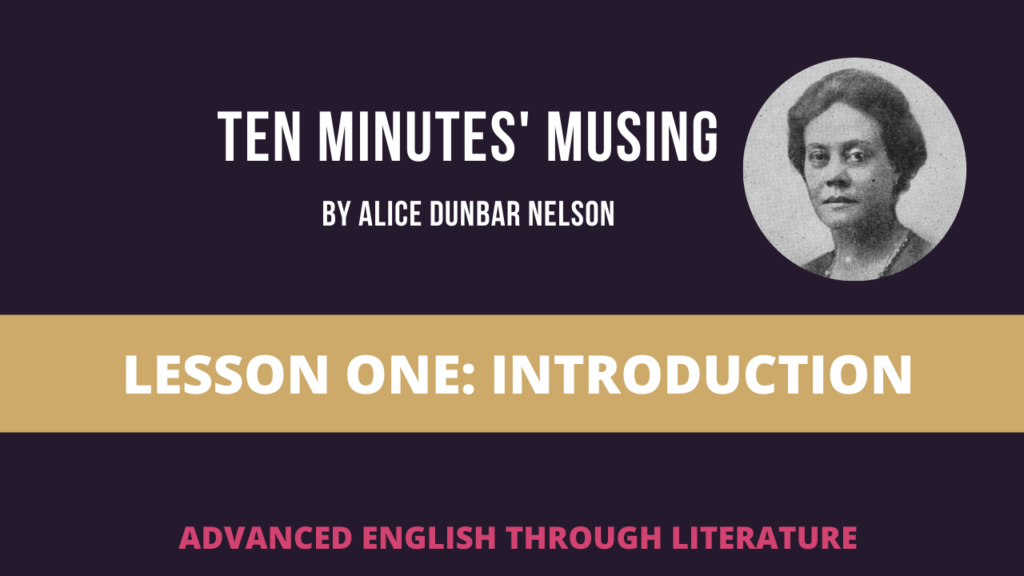Learn Advanced English through literature! This is the first of four lessons focused on the short story Ten Minutes’ Musing by Alice Dunbar Nelson. In the first lesson, we cover an introduction to the author and the context within which she was writing.
Lesson One: Introduction
You can watch the lesson here. The transcript is below.
Transcript:
Hello and welcome to Lesson One for the short story Ten Minutes’ Musing by Alice Dunbar Nelson.
If we haven’t met, my name is Sarah Rocha Coelho from Free Your English. I help Intermediate to Advanced Learners of English use English literature as a motivation to move forward to do lots of reading and speaking and it is my mission to help you communicate in your English with greater clarity and confidence.
So this is effectively a mini-course on this wonderful short story. There are four lessons and we are going to, in those four lessons, look at the following: Lesson One is an introduction the the author and also the context of the story. Lesson Two we will look at pre-reading vocabulary. Lesson Three will be a read-along and then Lesson Four we will look at discussing the meaning of the story.
So in terms of an introduction, we will first look at the author and the context in which she was writing. Alice Dunbar Nelson was an accomplished woman. She was a poet, novelist, journalist, teacher, diarist, political activist for civil rights, and she supported and worked for women’s rights and women’s suffrage. She was also part of an artistic movement known as the Harlem Renaissance.
The Harlem Renaissance was a significant social and cultural movement which happened as thousands of African Americans left the South moving to look for better opportunities and also to attempt to escape institutionalised racism.
African American musicians and authors, they gathered in Harlem and they painted, composed music, performed, wrote and just created and inspired each other. Harlem is a neighbourhood in New York in the United States and this movement was happening from roughly the 1910s to the mid 1930s.
Langsten Hughes was one of the most famous authors of the Harlem Renaissance and he wrote about the struggles of African Americans. The outcome of artistic genius that came from the Harlem Renaissance, it needs to be said, came despite immense oppression and systemic racism.
And the artists of the Harlem Renaissance, they rightfully wanted to take pride in, and celebrate, their history, their roots, achievements and culture. And these important artistic contributions of the Harlem Renaissance – they continue to provide inspiration.
Alice Dunbar Nelson was part of the first generation of Black Americans to be born free in the South after slavery had ended following the American Civil War. She published the story that we are going to read when she was very young and in her life she worked, as I’ve said, as many many different things including a teacher and of course being a published author.
So there you have an incredibly short summary of the Harlem Renaissance which is part of the context of her writing and a very brief introduction to Alice Dunbar Nelson.
Okay, pause the video. Imagine that you are in a classroom and imagine I’ve asked you to turn to your speaking partner and take a moment to answer this question: what was the Harlem Renaissance? So go ahead and talk about it in your own words or you could jot down on a piece of paper what you remember about it… and perhaps – what questions do you still have?
Of course, within such a short amount of time, it’s hard to do justice to these really important topics so I really encourage you to look further into the Harlem Renaissance and the issues that surrounded this flowering of artistic talent.

Novelist (noun)
= a writer of novels. (A novel is a long made up story about imaginary characters.)
E.g Jane Austen is a very famous English novelist.
Diarist (noun)
= a person who writes often in a diary.
E.g Anne Frank is a famous diarist who wrote about the Second World War.
Activist (noun)
= an activist is someone who works to bring change for the greater good to society either by campaigning in public or by working for an organisation. A political activist is someone who works to bring political change.
E.g Alice Dunbar Nelson was a political activist who spoke up for Black women and campaigned for better education and healthcare.
Suffrage (noun)
= the right to vote in political elections.
E.g Alice Dunbar Nelson was a paid activist and supporter of the women’s suffrage movement.
Movement (noun)
= a group of people with a particular set of aims, beliefs and ideas.
E.g The women’s suffrage movement was an important part of women gaining the vote.
Institutionalised racism (noun)
= the kind of racism that is buried within the rules and systems of a society or an organisation. The rules and systems allow an unfair advantage for some and harmful treatment for others based on race.
E.g There have been many reports of police violence coming from institutionalised racism.
Systemic racism is a phrase that means the same thing. (I.e the racism is built into the systems and structure of the society or organisation.)
Roots (noun)
= Your family, ethnic or cultural origins or the particular place you come from and the experiences you had while you were living there.
E.g I love going back to visit my parents on their farm. It’s always nice returning to my roots.
Interactive quiz:
Would you like to try the interactive quiz for this lesson? You can find it within the FREE Resource Library.

